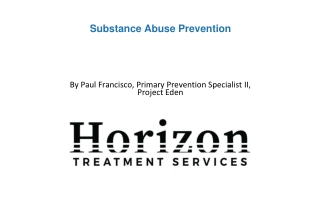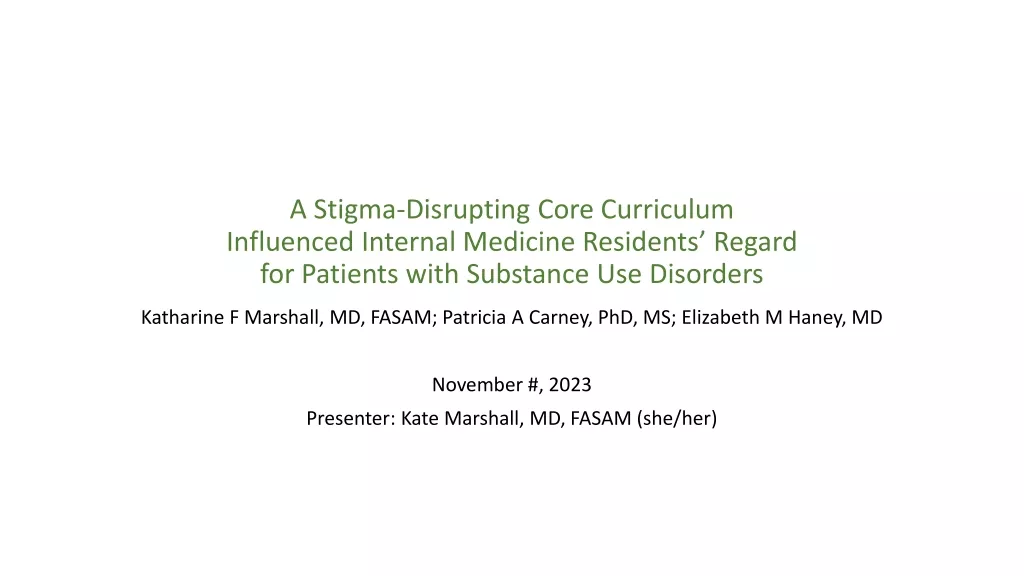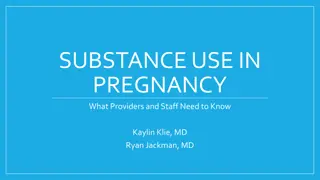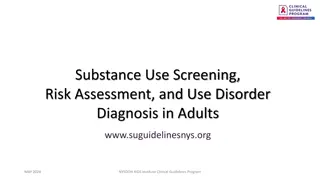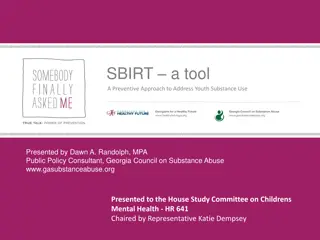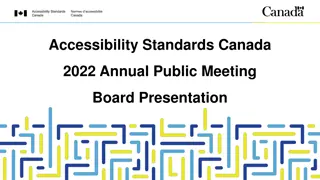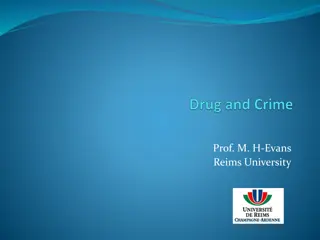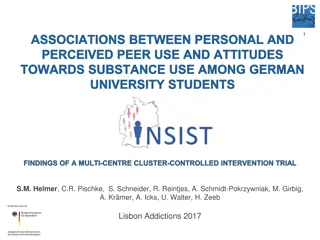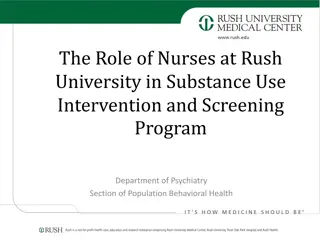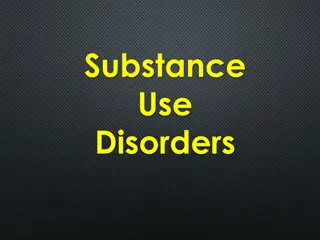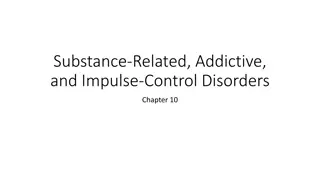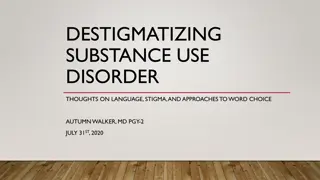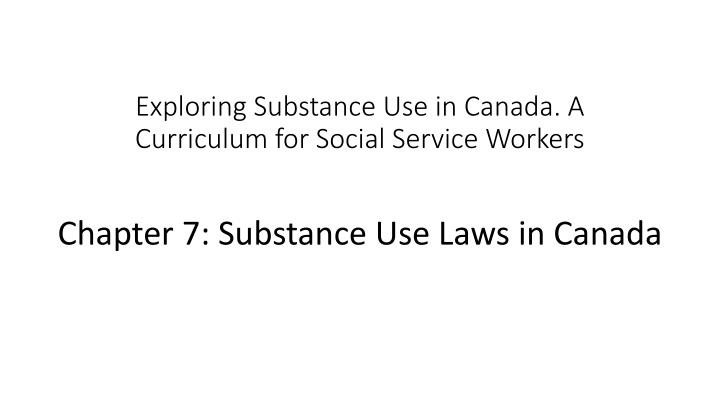
Substance Use Laws in Canada: History, Effects, and Reforms
Explore the history of substance use laws in Canada, debate on decriminalization and legalization, and understand the impacts on individuals and communities. Learn about the failures of the War on Drugs and the need for reforms towards a human rights and health promotion approach.
Download Presentation

Please find below an Image/Link to download the presentation.
The content on the website is provided AS IS for your information and personal use only. It may not be sold, licensed, or shared on other websites without obtaining consent from the author. If you encounter any issues during the download, it is possible that the publisher has removed the file from their server.
You are allowed to download the files provided on this website for personal or commercial use, subject to the condition that they are used lawfully. All files are the property of their respective owners.
The content on the website is provided AS IS for your information and personal use only. It may not be sold, licensed, or shared on other websites without obtaining consent from the author.
E N D
Presentation Transcript
Exploring Substance Use in Canada. A Curriculum for Social Service Workers Chapter 7: Substance Use Laws in Canada
Explore the history of substances and substance use policy in Canada Explain the main arguments for and against decriminalization and legalization of substances Recognize the effects of laws and policies on individuals, families, and communities Learning Objectives:
The War on Drugs The term war on drugs began with Ronald Reagan, the President of the United States in 1984. His wife Nancy began a popular, yet ineffective campaign, Just Say No . This campaign was based on abstinence and spawned other abstinence-based programs like DARE (Drug Abuse Resistance Education) (Drug Policy Alliance, 2021). This Photo by Unknown Author is licensed under CC BY-NC
An International War on Drugs The war on drugs has resulted in the criminalization, stigmatization and increased health harms of people who use substances (Henry, 2018). People in the political world agree; the global war on drugs has failed, with devastating consequences for individuals and societies around the world fundamental reforms in national and global drug control policies are urgently needed (Global Commission on Drug Policy, 2011, p. 3). United Nations Office on Drugs and Crime (UNODC) released a joint commitment in 2016 to address substance use, and it focused on reduction of access. There was also a recognition that substance use laws must shift to a more human rights and health promotion approach (United Nations, 2016).
People believe the war on drugs was an American phenomenon; however, Canada was a willing ally and created laws that targeted marginalized groups (Drug Policy Alliance, 2021). Consequences of the war on drugs also include incarceration and the myriad of challenges associated with having a criminal record. Yet Canada and other countries have continued to engage in a political war on drugs though according to Mallea (2014), it has not reduced the drug trade, eliminated production, or decreased the number of users (p. 11). Gordon (2006) suggests the criminalization of substances and people who use substances has not occurred in a vacuum; it has been a state policy that intersects profoundly with the racialized class relations of Canadian capitalist society (para. 4). In the 1980 s, Canadian Prime Minister Brian Mulroney invested in Canada s war on drugs based on the false belief that communities were being ravaged by drugs, though evidence on use suggested otherwise (Maynard, 2017). Canada s War on Drugs The war on drugs has been a world-wide phenomenon that resulted in the criminalization and incarceration of people who use substances; historically, the principal response to illegal drug use has been enforcement and incarceration (Wood et al., 2003, p. 165). Data from Canada and elsewhere show this approach fails to meaningfully reduce supply of or demand for drugs and results in many unintended negative consequences (Wood et al., 2003, p. 165); for example, overdose is a leading cause of premature mortality in North America (Marshall et al., 2011, p. 1429).
Substance Use Laws in Canada The Controlled Drug and Substances Act (CDSA) is the law responsible for overseeing Schedule I-VIII substances, which include stimulants, opioids, depressants, benzodiazapines, and steroids as well as their derivatives (Government of Canada, 2021a). The Director General s Office manages the CDSA and its Regulations and the Office of Controlled Substances develops legislation, regulations, policies and operations that support the control of illicit drugs and other substances (Government of Canada, 2021a). Employees of Health Canada, experts in the field, members of RCMP, and elected officials and their staff form committees to review substances and the laws associated with them. Canada is a member of the UN Office of Drug and Crime (UNODC), which guides Canadian laws and policies (Government of Canada, 2021a). To pass a law, the House of Commons (elected, lower Chamber), the Senate (appointed, upper Chamber), and the Monarch (Head of State, who is represented by the Governor General in Canada) work together.
Robin Maynard: Policing Black Lives https://youtu.be/1-JpQjhVvlM (Maynard, 2017).
The War on Drugs and the BIPOC Communities This racialized focus in the war on drugs has resulted in over- representation of incarceration for BIPOC (Black, Indigenous, People of Color) communities. Racialization strengthens systemic racism and reinforces structural violence (Khenti, 2014, p. 191). 80% of people who have been incarcerated have substance use disorders (Motiuk et al., 2003) and 54% of offenders were under the influence of alcohol and/or drugs at the time of the offence for which they were currently serving a sentence (Pernanen et al. 2002). The war on drugs has been a catastrophic failure that has directly impacted BIPOC communities and indirectly impacted all Canadians; war always destroys lives, produces a maximum of collateral damage, denies basic human and civil rights, and has little to do with justice (Nusbaumer, 2009, p. 369). In 2016, Indigenous Canadians accounted for 24.4% of the federal prison population, though they make up just 4.3% of the general population (Government of Canada, 2019). In 2010 2011, Black Canadians accounted for 10% of the federal prison population although Black Canadians only comprised 2.5% of the overall population (Wortley & Owusu-Bempah, 2011). We are incarcerating people for their substance use and this racialization of the war on drugs has resulted in blackness associated with criminality (Khenti, 2014)
What is Decriminalization of Drugs? https://youtu.be/9NKhpujqOXc (European Monitoring Centre for Drugs and Drug Addiction -EMCDDA, 2015).
The Netherlands and Decriminalization The Netherlands decriminalized substances in 1976 (Netherlands Ministry of Foreign Affairs, 2008). The Netherlands used a four-pillar approach focusing on: (i) preventing substance use and treating and rehabilitating people who use substances; (ii) reducing harm to users; (iii) diminishing public nuisance caused by people who use substances and; (iv) combatting the production and trafficking of drugs (European Monitoring Centre for Drugs and Drug Addiction-EMCDDA, 2019). Under the Netherlands policy, people who use substances are not normally arrested for possession (excluding cocaine and heroin), but they must receive treatment if they are arrested for another reason (Netherlands Ministry of Foreign Affairs, 2008). Traffickers are not arrested for selling small amounts of substances, but they may be arrested for selling them in large quantities (Government of the Netherlands, 2021). This Photo by Unknown Author is licensed under CC BY-SA The impacts of these changes resulted in marijuana, cocaine and heroin use dropping in the immediate years after it was decriminalized (Government of the Netherlands, 2021).
Countries That Have Decriminalized Substances Czechia The Netherlands Portugal Switzerland This Photo by Unknown Author is licensed under CC BY-ND
Substance Use Statistics Compared: Canada and The Netherlands Canada 7.9% of Canadians aged 15 and older report high risk cannabis use (Government of Canada, 2021). 19% of those ages 15-17 used cannabis and nearly 20.0% of Canadians between the ages of 15-64 reported having used cannabis in the past three months (Rotterman, 2021). In Canada, 2017, according to the Canadian Tobacco, Alcohol and Drugs Survey, the prevalence of opioid use was 11.8% (Canadian Centre for Substance Use and Addiction, 2020), and the number of opioid related deaths increased by 2% from 2016- 2020 with 24,626 apparent opioid toxicity deaths (Government of Canada, 2021). Netherlands There has been a decreasing trend in lifetime cannabis use among school-age children over the period 1999-2015 (EMCDDA, 2019). A study in 2017 on Health Behaviour in School-aged Children (HBSC) showed a decrease in lifetime prevalence of cannabis use among students aged 12-16 years from 16.5 % in 2003 to 9.2 % in 2017 (EMDDCC, 2019, p. 8). There has been an increase in the number of people who use opioids as experienced throughout Europe and North America (Kalkman et al., 2019), no increase has been described in the number of opioid-related deaths (p. 498).
Portugal and Decriminalization In 2001, Portugal decriminalized small amounts of all substances. Possession of substances for personal use and usage itself are still legally prohibited, but violations are exclusively administrative violations rather than criminal violations (Greenwald, 2010).) If someone is using substances, they are not charged with substance related offences; rather anyone convicted of drug possession is sent for treatment, but the person may refuse treatment without any penalty (Rego et al., 2021). Trafficking substances is still illegal and can be prosecuted (Greenwald, 2010). The Portuguese Government invested in treatment and evidence-based prevention programs (Rego et al., 2021). It recognized that treatment costs far less than imprisonment (Rego et al., 2021). This Photo by Unknown Author is licensed under CC BY-SA-NC
How Portugal Successfully Tackled Its Drug Crisis https://www.youtube.com/watch?v=uQJ7n-JpcCk (CBC News, 2017).
Substance Use Statistics Compared: Canada and Portugal Canada Substance related deaths have increased, and almost 96% of opioid related overdose deaths were accidental (Government of Canada, 2021). Access to treatment is provided by various provincial governments but access can be difficult as wait times for treatment is lengthy. For example, in Nova Scotia wait times for treatment, depending on the region, can last between 19-146 days (Nova Scotia Mental Health and Addictions, 2021). Portugal Deaths related to substance use have reduced dramatically (Greenwald, 2010). The number of people struggling with substance use disorders who chose to access treatment increased, there are treatment facilities readily available and there have been reductions in problematic use, substance use related harms and overcrowding in correctional facilities (Hughes & Stephens, 2010).
British Columbia is set to decriminalize What does this mean? (CBC, 2022).
Groups for Change in Laws Related to Substance Use Canadian Association of People who Use Drugs (CAPUD) Vancouver Area Network of Drug Users (VANDU) have a long history in advocacy for supervised consumption sites and prescription opioid programs Halifax Substance Users Network (HalifaxSUN) and HaliFIX in Nova Scotia have been working to promote overdose prevention through substance testing campaigns and sharing first-person stories of their substance use There are grassroots efforts to move towards substance use laws and policies that reflect a harm reduction approach in Canada. NAOMI had a successful supervised prescribed heroin project in Vancouver SALOME ran an Opioid Maintenance pilot project in Vancouver
Advocating for Change The Canadian Drug Policy Coalition are advocating to revise Canada s Drug Safety Act and focus on a public health and human rights approach by sharing information to help Canadians understand how/when/where policies were created and change policy based on evidence Advocacy groups across Canada that are speaking up to say the current approach is not working The legalization of Marijuana in Canada is an example of change by way of an evidence-based approach Groups like the Canadian Drug Policy Coalition, have determined the biggest problem to be a dichotomy between the funding and support to harm reduction programs and making the legal changes that could make piecemeal harm reduction programs obsolete
Getting To Tomorrow: Ending The Overdose Crisis https://youtu.be/1IEk1iYtJGw (Canadian Drug Policy Coalition, 2020).
Class Discussion What can we as Social Service Workers do to help solve this problem that has been defined by groups like the Canadian Drug Policy Coalition? This Photo by Unknown Author is licensed under CC BY
Self Care Please review the Self- Care module, and report back next class.
References Canadian Centre for Substance Use and Addiction. (2020). Prescription opioids. https://www.ccsa.ca/sites/default/files/2020-07/CCSA-Canadian-Drug-Summary-Prescription-Opioids- 2020-en.pdf Canadian Drug Policy Coalition. (2020, Oct. 5). Angel Gates: Insight from community on the devastating toll of Canada s drug policies. [Video]. Youtube. https://www.youtube.com/watch?v=MiWcXFvWdIc Canadian Drug Policy Coalition. (2020, Oct. 5). Getting to tomorrow: Ending the overdose crisis. [Video]. Youtube. https://www.youtube.com/watch?v=1IEk1iYtJGw Canadian Drug Policy Coalition. (2021). Drug law reform. https://drugpolicy.ca/our-work/issues/reforme-des-politiques-sur-les-drogues/ CBC News. (2022). B.C. receives exemption to decriminalize small-scale illicit drug possession. https://www.youtube.com/watch?v=tGV5JQ8AJbQ Drug Policy Alliance. (2021). A history of the drug war. https://drugpolicy.org/issues/brief-history-drug-war European Monitoring Centre for Drugs and Drug Addiction. (2015). What is decriminalization of drugs? [Video]. Youtube. https://www.youtube.com/watch?v=9NKhpujqOXc European Monitoring Centre for Drugs and Drug Addiction. (2019). Netherlands country drug report. https://www.emcdda.europa.eu/system/files/publications/11347/netherlands-cdr- 2019.pdf Global Commission on Drug Policy. (2011). War on drugs: Report of the Global Commission on Drug Policy. https://www.globalcommissionondrugs.org/ Gordon, T. (2006). Neoliberalism, racism, and the war on drugs in Canada. Social Justice, 33(1), 59-78. https://www.jstor.org/stable/29768352 Government of Canada. (2017). Canadian tobacco, alcohol and drugs survey (CTADS): Summary of results for 2017. https://www.canada.ca/en/health-canada/services/canadian- alcohol-drugs-survey/2017-summary.html Government of Canada. (2019). Department of Justice Spotlight on Gladue: Challenges, experiences, and possibilities in Canada s criminal justice system. https://www.justice.gc.ca/eng/rp-pr/jr/gladue/p2.html Government of Canada. (2021). Opioid and stimulant-related harms in Canada. https://health-infobase.canada.ca/substance-related-harms/opioids-stimulants/ Government of Canada. (2021a). Controlled substances. https://www.canada.ca/en/health-canada/services/health-concerns/controlled-substances-precursor-chemicals/controlled- substances.html Greenwald, G. (2010). Drug decriminalization in Portugal: Lessons for creating fair and successful drug policies. CATO Institute Whitepaper Series, 1- 38. https://ssrn.com/abstract=1464837 Henry, B. (2018). Stopping the harm: Decriminalization of people who use drugs in BC. https://www2.gov.bc.ca/assets/gov/health/about-bc-s-health-care-system/office-of-the-provincial- health-officer/reports-publications/special-reports/stopping-the-harm-report.pdf Hughes, C. E., & Stevens, A. (2010). What can we learn from the Portuguese decriminalization of illicit drugs? The British Journal of Criminology, 50(6), 999 1022, https://doi.org/10.1093/bjc/azq038 Husak, D. N. (2002). Legalize this! The case for criminalizing drugs. Verso Publishing. Kalkman, G. A., Kramers, C., van Dongen, R. T. van den Brink, W., & Schellekens, A. (2019). Trends in use and misuse of opioids in the Netherlands: a retrospective, multi-source database study. The Lancet, 4(10). 498-505. https://doi.org/10.1016/S2468-2667(19)30128-8
References Kalkman, G. A., Kramers, C., van Dongen, R. T., van den Brink, W., & Schellekens, A. (2019). Trends in use and misuse of opioids in the Netherlands: a retrospective, multi-source database study. The Lancet, 4(10). 498-505. https://doi.org/10.1016/S2468-2667(19)30128-8 Key Studios. (2014, Feb. 26). Municipal alcohol project PSA. [Video]. Youtube. https://www.youtube.com/watch?v=HcH71oiOd48.pdf Khenti, A. (2014) The Canadian war on drugs: Structural violence and unequal treatment of Black Canadians. International Journal of Drug Policy, 25, 190 195. https://health.gradstudies.yorku.ca/files/2016/09/The-Canadian-war-on-drugs-Structural-violence-and-unequal-treatment-of-Blacks Mallea, P. (2014). The war on drugs: A failed experiment. Dundurn Press. Marshall, B. D., Milloy, M. J., Wood, E., Montaner, J. S., & Kerr, T. (2011). Reduction in overdose mortality after the opening of North America s first medically supervised safer injecting facility: A retrospective population-based study. The Lancet, 377(9775), 1429-37. https://pubmed.ncbi.nlm.nih.gov/21497898/ Maynard, R. (2017). Policing black lives: State violence in Canada from slavery to the present. Fernwood Publishing. Motiuk, L., Boe, R., & Nafekh, M. (2003). The safe return of offenders to the community. Correctional Service Canada. https://www.csc-scc.gc.ca/research/sr2005-eng.shtml Netherlands Ministry of Foreign Affairs. (2008). FAQ drugs: A guide to drug policy. https://www.government.nl/topics/drugs Nova Scotia Mental Health and Addictions. (2021). Wait time trends. https://waittimes.novascotia.ca/procedure/mental-health-addictions-adult-services#waittimes-tier3 Nusbaumer, M. R. (2009). Hooked: Drug war films in Britain, Canada and the United States. Contemporary Justice Review, 12(3), 367-369. https://doi.org/10.1080/10282580903105921 Rego, X., Oliveria, M. J., Lameira, C., & Cruz, O. (2021). 20 years of Portuguese drug policy developments, challenges and the quest for human rights. Substance Abuse Treatment Prevention Policy, 16(59). https://doi.org/10.1186/s13011-021-00394-7 Rotterman, M. (2021). Looking back from 2020, how cannabis use and related behaviours changed in Canada. Statistics Canada Health Reports. https://www.doi.org/10.25318/82-003- x202100400001-eng SFU Public Square. (2020, July 31). Susan Boyd: Colonial history and racial stereotypes are deeply entrenched in Canadian drug policy. [Video]. Youtube. https://www.youtube.com/watch?v=8cEu2HfKy84\ Statista. (2020). Then & now; Portugal s drug decriminalization. https://www.statista.com/chart/20616/key-developments-since-portugal-decriminalized-drugs/ UNAIDS. (2020, March 3). Decriminalization works, but too few countries are taking the bold step. https://www.unaids.org/en/resources/presscentre/featurestories/2020/march/20200303_drugs United Nations. (2016). General assembly special session on the world drug problem. https://www.unodc.org/documents/postungass2016/outcome/V1603301-E.pdf Wood, E., Tyndall, M. W., Spittal, P. M., Li, K., Anis, A. H., Hogg, R. S., Montaner, J. S. G., O Shaughnessy, M. V. O., & Schechter, M. T. (2003). Impact of supply-side policies for control of illicit drugs in the face of the AIDS and overdose epidemics: Investigation of a massive heroin seizure. Canadian Medical Association Journal, 168(2), 165- 169. https://pubmed.ncbi.nlm.nih.gov/12538544/ Wortley, S., & Owusu-Bempah, A. (2011). The usual suspects: Police stop and search practices in Canada. Policing and Society, 21(4), 395 407. https://www.researchgate.net/publication/238046161_The_Usual_Suspects_Police_Stop_and_Search_Practices_in_Canada.

